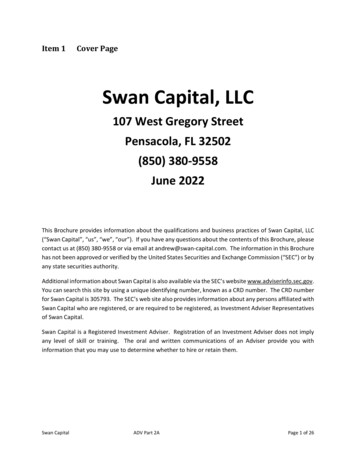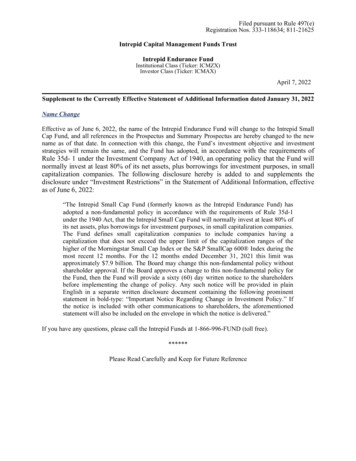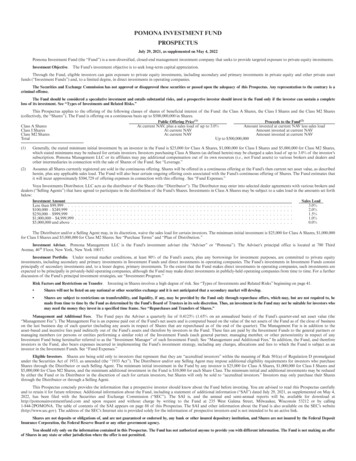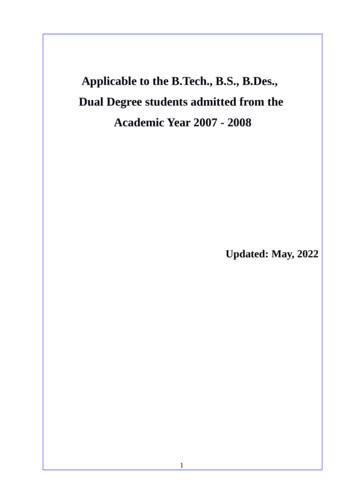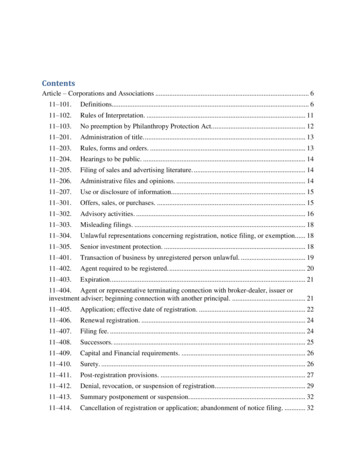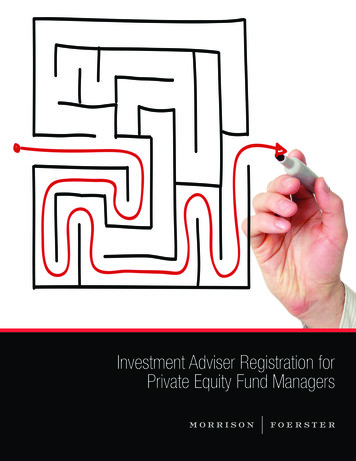
Transcription
Investment Adviser Registration forPrivate Equity Fund Managers
In 2011, the Dodd-Frank Act created a fundamental shift inregistration requirements for private equity, venture capitaland hedge fund managers. Five years later, the industry— and its regulators — have largely adjusted to the newregime.Still, questions arise about which fund managers mustregister, with whom, and when.In this handbook, we summarize who may or mustregister (and where), how registration and exemptionsimpact fund managers in terms of reporting andcompliance obligations, and related timetables.We note that this handbook contains only generalsummaries of the Advisers Act, the Dodd-Frank Act, SECrules and state laws. Please contact your Morrison &Foerster Private Funds Group attorney for more detailedguidance.
Table of ContentsWho Must Register?. 4Registration Cheat Sheet. 9Table 1: Where to Register?. 10Table 2: Exemptions from SEC Registration. 11Table 3: When is SEC Registration Permissiblefor Small and Mid-Sized Advisers?. 12Ongoing Compliance Obligations. 13
Who Must Register?BackgroundPrior to the Dodd-Frank Act, an adviser with fewer than15 clients that did not hold itself out as an investmentadviser was generally exempt from registration. Inapplying the numerical limit in the fewer-than-15clients exemption, the SEC generally did not requireinvestment advisers to “look through” a private fund tocount the individual investors as separate clients. Asa result, very few private fund managers were requiredto register as investment advisers and were, therefore,exempt from many of the compliance and disclosureobligations under the Advisers Act.The Dodd-Frank Act changed all of that, andinvestment advisers with assets under managementin excess of 100 million are generally now required toregister with the SEC.Definition of “Investment Adviser”The registration and compliance obligations underthe Advisers Act apply to “investment advisers,”which are generally defined as “any person who, forcompensation, engages in the business of advisingothers, either directly or through publications or writings,as to the value of securities or as to the advisability ofinvesting in, purchasing, or selling securities, or who,for compensation and as part of a regular business,issues or promulgates analyses or reports concerningsecurities,”1 other than advisers which are: banks or bank holding companies; lawyers, accountants, engineers or teachers whoseperformance of advisory services is incidental totheir profession; certain broker-dealers; newspaper or magazine publishers; advisers whose advice or analyses relates to certainU.S. government-related securities; nationally recognized statistical rating organizations; family offices (described further on page 11); or other persons as designated by the SEC.Most private equity fund managers provide advice withrespect to securities and, therefore, generally qualifyas investment advisers. If an investment adviser solelyadvises about matters other than securities (such asadvice about non-securities real estate or preciousmetals), however, it may not be an “investment adviser”within the meaning of the Advisers Act, and would notbe subject to the registration requirements under theAdvisers Act.Thresholds for SEC RegistrationThe thresholds for federal registration of investmentadvisers is generally 100 million in assets undermanagement (“AUM”), subject to certain exceptions.Under the Advisers Act and its related rules, thefollowing three categories of advisers arise: Small Advisers ( 25 million in AUM) – generallyprohibited from registering with the SEC, andmust register with the state regulators, unless anexemption applies. Mid-Sized Advisers ( 25 – 100 million in AUM)– generally prohibited from registering with theSEC, and must register with state regulators,subject to certain exceptions and the “buffer” foradvisers with between 100 million and 110million in AUM.2 Large Advisers ( 100 million in AUM) – generallyrequired to register with the SEC.These thresholds are discussed in more detail inTable 1.Calculating Assets UnderManagementThe first step in determining whether an advisermust register with the SEC or state regulators is tocalculate the adviser’s AUM. The SEC has adopteda uniform method for calculating AUM, providingthat advisers must include in their AUM securitiesportfolios (including private equity funds) for whichthey provide continuous and regular supervisory ormanagement services, including family or proprietaryassets,3 assets managed without receivingcompensation, and assets of foreign clients. Underthe rules, advisers must calculate their AUM ona gross basis, that is, without deduction of anyoutstanding indebtedness or other accrued butunpaid liabilities.4Morrison 4 Foerster
The instructions for Form ADV provide specificguidance for fund managers in calculating their AUM.Specifically, the instructions provide that: Advisers to private equity funds are required toinclude the value of any “private fund” over whichthey exercise continuous and regular supervisoryor management services, regardless of the natureof the assets held by the fund.5 “Private funds” aredefined as any issuer that would be an investmentcompany as defined in Section 3 of the InvestmentCompany Act but for the exemptions in Section3(c)(1) or Section 3(c)(7) of that Act (which are theexemptions upon which most private equity fundsrely). Value is based on the current market value (or fairvalue where current market value is unavailable) ofthe private equity fund’s assets and the contractualamount of any uncalled commitments. Advisers that calculate fair value in accordance withGAAP or another international accounting standardfor financial reporting purposes are expected to usethat same basis for purposes of determining thefair value of their AUM; but other advisers, actingconsistently and in good faith, may use another fairvaluation standard.When Is SEC Registration Permissiblefor Small or Mid-Sized Advisers?While advisers with less than 100 million in AUM aregenerally prohibited from registering with the SEC,the SEC has provided certain exceptions to thisrule (thereby permitting SEC registration for certainsmaller advisers). These exceptions apply to (i) certainpension consultants, (ii) advisers affiliated with an SECregistered investment adviser, (iii) advisers expecting tobe eligible for SEC registration within 120 days of filingan initial Form ADV, (iv) certain multi-state investmentadvisers; and (v) certain internet advisers. Theseexemptions from the prohibition on SEC registration arediscussed further in Table 3.The rules also provide a buffer for advisers withclose to 100 million in AUM to help these advisersdetermine whether and when they will be required toswitch between state and SEC registration. The bufferprovides that (i) advisers with between 100 million and 110 million in AUM will be permitted, but not required,to register with the SEC and (ii) once an adviser isregistered with the SEC, it is not required to withdrawits registration until it has less than 90 million in AUM.Eligibility for registration is determined annually as partof an adviser’s annual update amendment to its FormADV.Since federal registration preempts state registration,a small or mid-sized adviser may wish, if possible, toregister with the SEC instead of the state authoritiesif, for example, the adviser would be subject to moreonerous state rules or would be required to file and payregistration fees in more than one state.Exemptions from SEC RegistrationInvestment advisers that would otherwise be required toregister with the SEC may be able to rely upon exemptionsfrom SEC registration that were created or affected bythe Dodd-Frank Act.6 The following describes certainexemptions for private fund managers.Advisers Only to Venture Capital FundsU.S. and non-U.S. fund managers that advise solelyventure capital funds, regardless of the number or the sizeof the funds, are exempt from registration.7However, managers relying on the venture capitalexemption are considered “Exempt Reporting Advisers,”subject to certain limited public reporting requirements,including certain parts of Form ADV, and certain limitedcompliance obligations, discussed below.Defining “Venture Capital Funds”For purposes of the rules, a “venture capital fund” isdefined as a “private fund”8 that: represents to its investors and potential investorsthat it is pursuing a venture capital strategy; does not exceed the 20% basket for “nonqualifying investments,” which we discuss below; does not borrow, issue debt obligations, provideguarantees, or otherwise incur leverage in excessof 15% of the fund’s capital commitments, whichborrowing, indebtedness, guarantee9 or leverageis on a short-term basis only (for a non- renewableterm of no longer than 120 days);10 does not offer its investors redemption or othersimilar liquidity rights except in extraordinarycircumstances, such as withdrawal or excuse rightsfor legal or regulatory requirements11; and is not registered under the Investment CompanyAct and has not elected to be treated as a businessdevelopment company.Morrison 5 Foerster
investment).Defining “Qualifying Investments”The rules define “qualifying investments” as:12 any equity security issued by a “qualifyingportfolio company” that is directly acquired bythe private fund from the company (“directlyacquired equity”); any equity security issued by a qualifying portfoliocompany in exchange for directly acquired equityissued by the same qualifying portfolio company;or any equity security issued by a companyof which a qualifying portfolio company is amajority-owned subsidiary13, or a predecessor,and that is acquired by the fund in exchange fordirectly acquired equity described above.A “qualifying portfolio company”14 is defined as anycompany that: at the time of any investment by the private fund,is not a reporting or foreign traded companyand does not control, is not controlled by or isnot under common control with, a reporting orforeign traded company; does not borrow or issue debt obligations inconnection with the private fund’s investment inthe company and then distribute to the privatefund the proceeds of such borrowing or issuancein exchange for the private fund’s investment;and is not itself a private fund or other pooledinvestment vehicle (i.e., is an operatingcompany).The rules also clarify that: If the fund satisfies the 20% limit, but laterexceeds it (e.g., as a result of an increase in thevalue of the investment), the fund is not requiredto dispose of the investment, but would beprohibited from acquiring more non-qualifyinginvestments until the value of its then-existingnon-qualifying investments falls below the 20%limit. Previously acquired securities of a company thatsubsequently becomes a reporting company(e.g., as a result of an IPO) may be treated as aqualifying investment and, therefore, would notcount against the fund’s 20% basket. However,a fund could not later acquire the company’spublicly traded securities in the secondarymarket unless it had sufficient room in its 20%basket. Investments in wholly-owned intermediateholding companies that are formed solely fortax, legal or regulatory reasons to hold the fund’sinvestment in a qualifying portfolio company, canbe disregarded for purposes of the 20% limit andthe definition of “qualifying portfolio companies.”Advisers Only to Private Funds with less than 150 Million in Assets Under ManagementThe private fund adviser exemption exempts fromregistration any adviser with its principal office andplace of business in the United States that: acts solely as an investment adviser to one ormore “qualifying private funds”; and20% Basket for Non-Qualifying InvestmentsThe rules include a 20% basket for non-qualifyinginvestments, thus allowing a fund to qualify as aventure capital fund even if it makes other types ofinvestments, such as bridge loans, investments inpublicly offered securities, leveraged buyouts, orinvestments in other venture capital funds.The 20% limit is calculated immediately after thefund’s purchase of a non-qualifying investment(other than short-term holdings15) by calculating thetotal value16 of all the fund’s assets held at that timethat are invested in non-qualifying investments as apercentage of the fund’s total commitments (i.e., aftertaking into account the newly acquired non-qualifying has assets under management attributableto “qualifying private funds” of less than 150million.17Like the venture capital fund exemption, advisersrelying on the private funds exemption are ExemptReporting Advisers, subject to certain limitedpublic reporting requirements, including certainparts of Form ADV, and certain limited complianceobligations, which we discuss below.Advising Only “Qualifying Private Funds”Unlike the exemption for advisers to venture capitalfunds (which limits “private funds” to investmentMorrison 6 Foerster
funds that rely on Section 3(c)(1) or Section 3(c)(7) of theInvestment Company Act), the term “qualifying privatefunds” under the private funds exemption includesfunds that rely on any of the exemptions under Section3 of the Investment Company Act, including Section3(c)(5)(C), upon which many real estate funds rely. Asa result, advisers are permitted to advise a broadercategory and a greater number of funds and still relyon this exemption. However, advisers must treat each“qualifying private fund” as a “private fund” for otherpurposes of the Advisers Act (including for purposes ofcalculating the 150 million threshold described below).Calculating the 150 Million ThresholdAdvisers relying on this exemption must annuallycalculate the amount of private fund assets (includingassets of any qualifying private fund) they have undermanagement and report these amounts in the adviser’sannual amendments to its Form ADV. Advisers reporting 150 million or more of private fund AUM do not qualifyfor the private fund adviser exemption, and are requiredto register under the Advisers Act unless anotherexemption applies. Notably, while advisers may berequired to register under the Advisers Act as a resultof changes to their AUM as reported in their annualForm ADV updating amendments, they do not lose thebenefit of the exemption as a result of fluctuations in theadviser’s AUM during the course of a year.Application to Non-U.S. AdvisersThe private funds exemption also applies to an adviserwith its principal office and place of business outside ofthe United States if the adviser: has no client that is a U.S. person except for one ormore qualifying private funds; and all assets managed by the adviser at a place ofbusiness in the United States are solely attributableto private fund assets, the value of which is lessthan 150 million.Non-U.S. Advisers Advising Only “Qualifying PrivateFunds.” When determining whether all of the nonU.S. adviser’s clients located in the United States arequalifying private funds (described above), a non-U.S.adviser whose principal office and place of businessis outside the United States may enter the U.S.market and rely on the exemption without regard toits advisory services, clients or AUM outside of theUnited States (i.e., the adviser does not count its nonfund clients outside the United States). However, allassets managed by the investment adviser at a place ofbusiness in the United States must be solely attributableto “private fund assets,” the total value of which is lessthan 150 million.The rules also clarify that, for non-U.S. advisers whoseprincipal office and place of business is outside theUnited States, a client will not be considered a U.S.person for purposes of this exemption if the client wasnot a U.S. person at the time it became a client of theadviser. For example, an adviser could still rely on theprivate adviser exemption even if one of its non-U.S.clients that is not a private fund (such as an individualor a corporation) relocates to the United States or laterbecomes a U.S. person.Foreign Private AdvisersThe “foreign private advisers” exemption is availableonly to advisers that: have no place of business in the United States; have, in total, fewer than 15 clients in the UnitedStates and investors in the United States countedon a “look through” basis in private funds advisedby the adviser; have less than 25 million in AUM attributableto clients in the United States and investors inthe United States in private funds advised by theadviser; do not hold themselves out as an investmentadviser in the United States; and do not act as an investment adviser to a registeredinvestment company or a company that has electedto be a business development company.18Counting Clients (and Investors)The exemption for foreign private advisers requiresnon-U.S. advisers to “look through” the private fundsthey advise and count the U.S. investors in those fundstoward the 15-client maximum (regardless of whetherthe fund is a U.S. or non-U.S. domiciled fund).The rule also includes a number of special rules forcounting clients, including a rule that permits anadviser to treat as a single “client” two or more legalorganizations that have identical shareholders, partners,limited partners, members, or beneficiaries. Advisersrelying on the foreign private advisers exemption arenot required to double-count a private fund and theMorrison 7 Foerster
investors in that fund under certain circumstances.19 has no clients other than “family clients;”Further, foreign private advisers are not required to “lookthrough” funds that do not rely on Section 3(c)(1) orSection 3(c)(7) of the Investment Company Act. Whilemost private equity funds rely on these exemptions (andtherefore would be considered “private funds” under thenew rules), certain funds, such as real estate funds, relyon other exemptions and would not be subject to the“look through” rules. is wholly owned by family clients and is exclusivelycontrolled (directly or indirectly) by one or morefamily members and/or family entities; andAdvisers Only to SBICsSection 203(b)(7) of the Advisers Act provides anexemption from registration for any adviser, who is not abusiness development company, that solely advises: does not hold itself out to the public as aninvestment adviser.“Family clients” include, among others, family membersand former family members, key employees andcertain former key employees, certain non-profits andcharitable organizations or certain trusts, and certainentities owned by and operated for the benefit of familyclients. small business investment companies (“SBICs”) thatare licensed under the Small Business InvestmentAct of 1958 (the “SBA Act”); entities that have received notice to proceed toqualify for a license as an SBIC under the SBA Act;or affiliates of a licensed SBIC where the affiliate hasa pending application for a license under the SBAAct.Intrastate AdvisersThe exemption for intrastate advisers generally appliesto advisers: that are not advisers to “private funds;” whose clients are residents of the state in which theadviser maintains its principal office and place ofbusiness; and that do not furnish advice, analyses or reportswith respect to securities listed (or admitted tounlisted trading privileges) on any national securitiesexchange.Advisers to Family OfficesSubject to certain exceptions, a “family office” isgenerally excluded from the definition of “investmentadviser.” For these purposes, a “family office” is definedas a company that:Morrison 8 Foerster
Registration Cheat SheetAre you an “investment adviser” within the meaning of the Advisers Act?See discussion on page 4, under the heading Definition of “Investment Adviser”YESNOYou are not required to registerunder the Advisers Act, andare generally not required toregister under state lawAre you required to registerwith the SEC or one or morestate authorities?See Table 1 on page 10If you are otherwise requiredto register with the SEC isan exemption available?See Table 2 on page 11If you are required toregister with one or morestate authorities, is there anexemption that would permit youto register with the SEC instead?See Table 3 on page 12Morrison 9 Foerster
Table 1: Where to Register?The first step in determining whether an adviser must be registered with the SEC or the state authorities is toassess an adviser’s assets under management.Type of AdviserSmall AdvisersLess than 25 millionin AUMSEC RegistrationProhibited, unless the state in which it maintainsits principal office and place of business hasnot enacted an investment adviser statute (e.g.,Wyoming), or unless it acts as an investmentadviser to a registered investment company, inwhich cases the adviser must register with theSEC, unless otherwise exempt.Permitted, but not required, if relying on anexemption from the prohibition on registrationdescribed in Table 3 on page 12.Mid-Sized AdvisersBetween 25 millionand 100 million inAUMState Registration20Required for small advisers that arenot registered with the SEC, unlessan exception applies under statelaw.Not required for small advisers thatare registered with the SEC, sincefederal registration preempts stateregistration requirements.Prohibited if the adviser is (i) required to beregistered (and is not exempt from registration) withthe state regulators in the state in which it maintainsits principal office and place of business, and (ii)subject to examinations as an investment adviserwithin such state (a “Covered Mid-Sized Adviser”),21unless an exception applies.Required for mid-sized advisersthat are not registered with the SEC(including advisers relying on anexemption from federal registration,such as Exempt ReportingAdvisers), unless an exceptionapplies under state law.Permitted, but not required, (i) under the bufferrules if the Covered Mid-Sized Adviser hasbetween 100 million and 110 million in AUM, or(ii) if the Covered Mid-Sized Adviser is required toregister with 15 or more states, or (iii) if relying onan exemption from the prohibition on registrationdescribed in Table 3 on page 12.Not required for mid-sized advisersthat are registered with the SEC,since federal registration preemptsstate registration requirements.Required, unless an exemption applies, if theadviser (i) is not a “Covered Mid-Sized Adviser”(such as advisers with their principal office andplace of business in New York or Wyoming) or(ii) the adviser advises a registered investmentcompany or a company that has elected to be a“business development company.”Large AdvisersRequired, unless an exemption applies. 100 million or more inAUMRequired for large advisers thatare not registered with the SECbecause they are relying on anexemption from federal registration(including Exempt ReportingAdvisers), unless an exceptionapplies under state law.Not required for large advisers thatare registered with the SEC, sincefederal registration preempts stateregistration requirements.Morrison 10 Foerster
Table 2: Exemptions from SEC RegistrationWhere an adviser is otherwise required to register with the SEC, the adviser may be able to rely on anexemption from SEC registration.Type of AdviserAdviser manages solelyprivate funds and has lessthan 150 million in AUMSEC RegistrationRegistration with State(s)Not required, but, if relyingupon the exemption, subjectto modified reportingobligations of an ExemptReporting Adviser.Required in accordance with statelaw, unless registered with the SECor exempt under state law.Not required, but, if relyingupon the exemption, subjectto modified reportingobligations of an ExemptReporting Adviser.Required in accordance with statelaw, unless registered with the SECor exempt under state law.“Foreign private advisers”Not required.Required in accordance with statelaw, unless registered with the SECor exempt under state law.Intrastate adviser whereadviser does not advise“private funds”Not required.Required in accordance with statelaw, unless registered with the SECor exempt under state law.Advisers to “family offices”Not required.Required in accordance with statelaw, unless registered with the SECor exempt under state law.SBIC advisers meetingconditions under Section203(b)(7) of the Advisers ActNot required.Required in accordance with statelaw, unless registered with the SECor exempt under state law.Adviser manages solelyventure capital fundsMorrison 11 FoersterNote that Exempt Reporting Advisersrelying upon the exemption are notregistered with the SEC, and thereforemay be subject to state registration(although many states have adoptedparallel exemptions for these advisers).Note that Exempt Reporting Advisersare not registered with the SEC, andtherefore may be subject to stateregistration (although many stateshave adopted parallel exemptions forthese advisers).
Table 3: When Is SEC Registration Permissible forSmall and Mid-Sized Advisers?Certain small and mid-sized advisers may wish to register with the SEC in order to avoid state registration. Toregister with the SEC, these advisers must rely on an exemption from the prohibition on SEC registration. Exceptas noted below, these exemptions allow small and mid-sized advisers to choose to register with the SEC even ifthey do not meet the AUM thresholds described in Table 1.Type of AdviserSEC Registration Pension Consultants: Advisers that are “pensionconsultants” with respect to assets for planshaving an aggregate value of at least 200million meeting certain conditions under Rule203A-2(a).Optional. Multi-state Advisers: Advisers required toregister with 15 or more states meeting certainconditions under Rule 203A-2(d).22State Registration. Internet Advisers: Internet investment advisersmeeting certain conditions under Rule 203A-2(e). Affiliates of Registered Advisers: Advisersthat control23, are controlled by, or are undercommon control with, an investment adviser thatis registered with the SEC, and whose principaloffice and place of business is the same as theregistered adviser.24Required in accordance with state law, unlessregistered with the SEC or exempt under state law. Advisers Eligible for Registration within 120days: An adviser that expects to be eligible forSEC registration within 120 days after the dateit registers with the SEC and that meets certainconditions under Rule 203A-2(c).Morrison 12 Foerster
Ongoing Compliance ObligationsUnregistered and State-RegisteredInvestment AdvisersA state-registered investment adviser is generallysubject to the statutes, rules and regulations in thestate(s) in which the investment adviser transactsbusiness. Certain state laws and regulations (e.g.,anti-fraud provisions) apply even to an investmentadviser that is not registered in that state. AdvisersAct registration generally preempts only stateregistration and related requirements, rather than allstate regulation.In addition, a limited number of Advisers Act provisionsapply to investment advisers that are unregisteredunder the Advisers Act, including, without limitation,the following:Anti-Fraud ProvisionsThe anti-fraud provisions of the Advisers Act prohibitadvisers from employing “any device, scheme, orartifice to defraud any client or prospective client,”and require advisers, among other things, todisclose all material facts (and not make any materialomissions) and to disclose to their clients actual andpotential conflicts of interest.Principal TransactionsSection 206(3) of the Advisers Act provides thatit is unlawful for an investment adviser acting asprincipal for its own account, knowingly to sell anysecurity to or purchase any security from a client,or acting as broker for a person other than suchclient, knowingly to effect any sale or purchaseof any security for the account of such client,without disclosing to such client in writing beforethe completion of such transaction the capacity inwhich he or she is acting and obtaining the consentof the client to such transaction.Exempt Reporting AdvisersIn addition to the compliance obligations of advisersthat are not registered under the Advisers Actdiscussed above, Exempt Reporting Advisers aresubject to a limited subset of compliance obligationsunder the Advisers Act.Form ADVExempt Reporting Advisers must submit to theSEC, and periodically update, a truncated versionof the Form ADV,25 which is publicly available andaccessible through the SEC’s website.Pay to Play RulesSEC ExaminationsThe SEC’s “pay to play” rules (i) prohibit paymentsto certain third parties to solicit government clientson behalf of an adviser, (ii) restrict contributions andpayment to certain government officials and politicalparties, and (iii) prohibit an adviser from receivingcompensation for advisory services within two yearsafter a political contribution is made by the adviser(or its covered associates) to an official of certaingovernment entities.While the SEC has indicated that it does notanticipate that its staff will conduct complianceexaminations of Exempt Reporting Advisers on aregular basis, the SEC has the authority to do soand may examine the records of Exempt ReportingAdvisers.Supervisory RequirementsAll unregistered exempt investment advisers aresubject to the supervisory requirements in Section203(e)(6) of the Advisers Act, which requires advisersto supervise those who act on their behalf with aview to preventing violations of securities laws.SEC Registered Investment AdvisersTo the extent an investment adviser registers withthe SEC, it will generally be subject to the full scopeof the Advisers Act (including, without limitation, theobligations of unregistered investment advisers).These obligations include, without limitation: filing current disclosures on
its registration until it has less than 90 million in AUM. Eligibility for registration is determined annually as part of an adviser's annual update amendment to its Form ADV. Since federal registration preempts state registration, a small or mid-sized adviser may wish, if possible, to register with the SEC instead of the state authorities
